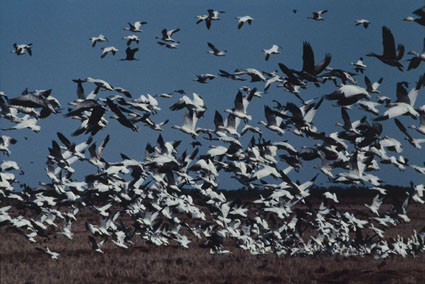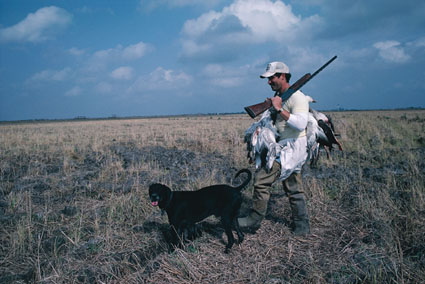 It was Valentine’s Day, the date of an annual post-duck-season goose hunt among a group of hard-charging waterfowlers in east-central Arkansas. Taxidermist and outfitter Pat Pitt, his two sons Stephen and Patrick, and six other hunters were up at first light looking for “white” geese (snows, blues and Ross’) as the birds flew off roosting ponds.
It was Valentine’s Day, the date of an annual post-duck-season goose hunt among a group of hard-charging waterfowlers in east-central Arkansas. Taxidermist and outfitter Pat Pitt, his two sons Stephen and Patrick, and six other hunters were up at first light looking for “white” geese (snows, blues and Ross’) as the birds flew off roosting ponds.
They were driving the through countryside when Pat suddenly spotted a group of snows settling into a sprawling wheat field. A quick scan with a binocular revealed that thousands of birds were in the flat, clean field. The geese were slowly moving toward the hunters’ side of the field to get away from a pickup truck that was parked on the other side.
Pat knew exactly what to do, and quickly got all nine of his hunters in a deep, hard-bottom ditch that paralleled the field and ran the length of the wheat. In minutes Pat and his crew were strung out along the ditch, in the area where the geese were soon massed.
“They had no idea we were there, and they were only 10 steps away from the ditch edge,” Pat remembers. “We were strung out about 30 yards apart, and we just started walking up the ditch side toward the geese. When we popped our heads up, the geese flushed, and we all just started shooting.
“The first volley I guess we likely dropped 60 to 70 birds, and by the time they finally rose, circled, and left, we’d taken 161 geese,” he says. “It must have been quite a show to the people in the truck on the far side of the field.
“That sounds like overkill to most sportsmen, because it’s so many geese, and we took them in such an unconventional way,” Pitt continues. “But we did everything legally. We picked up every goose with our dogs, and all the birds were cleaned and utilized by our hunters. It’s not classic goose hunting over decoys, not by a long shot. But ‘walking up’ birds sure is effective. That day we shot 371 snow geese — which is our one-day record. We’ve had other days, though, when we’ve taken 298 and 244 birds. One year, my sons, friends and I shot 2,391 geese hunting this way.”
Pitt may sound like a goose game hog and wildlife law violator. But in reality he’s a staunch conservationist, one of the few hunters who actively pursues late-season snow geese, trying to bring their numbers under control — for the good of the birds and their nesting habitat.
For years Canadian waterfowl biologists have been alarmed that booming snow goose populations are decimating their tundra nesting grounds. Too many snow geese are literally eating their way to possible oblivion. An overabundance of birds denudes the slow-growing tundra, eliminating important summer food in traditional goose nesting areas. With no other food or other prime nesting areas available, snow goose populations could completely collapse and bird numbers would be decimated if populations are not brought properly into balance with their habitat.
Biologists and waterfowl game managers have “taken the gloves off” for the snow goose harvest, hoping to reduce bird numbers to manageable populations and save the tundra. As a result, snow goose hunting extends far beyond the traditional fall/winter waterfowl season. In many states, like Arkansas, where snows are abundant, there are no limits on snow geese. Electronic calls are legal, guns need not have plugs, and hunting can be done for many weeks beyond traditional seasons.
Yet for all the liberal harvest adjustments, snow geese wise up quickly, and traditional hunting methods have not made much of a dent in the bird population. Thus the tundra — and “white” geese — are still in jeopardy.
Smart Shooting
Enter Pitt, and his “driving” method for collecting late-season snows.
“I love hunting waterfowl over decoys; it’s the love of my life,” he explains. “I’ve hunted ducks and geese all over the world this way, and it’s the best activity there is in the outdoors. But snow geese are so smart that to reduce their numbers effectively as we need to do, traditional hunting for them over decoys, or even pass-shooting them, doesn’t get it done. Snow geese are wise to big decoy spreads. Years ago we could decoy them with paper plates. Now, putting out a couple thousand rags and decoys will get a few birds in, but mostly juvenile geese, and certainly not in the numbers needed to trim tundra nesting populations. And electronic calls worked great, too, at least early on. But now the birds are wise to that tactic, as well.
“As far as I’m concerned, ‘walking up’ geese — or driving them — is the best way to get a lot of birds in a short time. Farmers, duck hunters and biologists love it, because it really does work on snows in Arkansas fields.”
The tactic isn’t fancy, but it takes planning and skill to pull off consistently. In addition, not every drive scores big on geese. “Snows are incredibly spooky,” says Pitt. “An unruly dog or a hunter coughing, talking or waving a shotgun, and other seemingly minor things, can botch an entire goose stalk.
“A field with 10,000 snow geese is remarkably loud. You can barely hear another person speak, but the birds can hear you very well. They’ll spook in a second, and the whole drive is ruined because of just one moment of carelessness. A lot of planning goes into a goose drive. You’ve got to locate birds, then make sure to have permission to hunt the field. Next you’ve got to plan the stalk, decide where to put standers and where the drivers will work from, and then figure out how to get everyone into position without spooking the birds prematurely. It’s pretty involved, and takes some experience. But it sure brings results.”
Pitt is quick to point out that “driving” snow geese isn’t for everyone. And he has great respect for other hunters who prefer setting out large decoy spreads trying to dupe snows into shooting range.
“If I see a decoy spread, I don’t go anywhere near it when we’re scouting for places to drive birds,” he explains. “Hunters with decoys have a right to be there doing their thing, and I’m not going to interfere with them. Heck, I prefer to hunt over decoys, too, and I would, if it resulted in plenty of snow geese being harvested. But it doesn’t, at least compared to ‘walking’ birds.”
The Proper Method
“Driving birds takes plenty of thoughtful coordination, and to do it right you need six to a dozen or more shooters,” explains Pitt’s hunting partner Bill Cooksey of Avery Outdoors in Memphis. “It’s not just something anyone can go out and do well.” Cooksey says pre-hunt scouting is important, and it’s best done in flatland areas where hunters can see goose concentrations from long range with binoculars. Rice, bean and wheat country is best. But the first order of business is locating birds on a roost, which usually is a pond or lake.
“You’ve got to watch birds at first light and see where they’re headed,” Cooksey says. “Sometimes it’s best to have two or three hunters in vehicles on several different roosting ponds watching birds. This way if you lose a group of birds as they’re flying, someone in another vehicle likely will stay with a flock until they land in a field suitable to drive.”
A field worth “driving” should hold at least 100 geese, but it’s not unusual to work a field harboring 5,000 to 10,000 birds.
Once a field has been located and Pitt has permission to hunt, he begins surveying the spot to pull off a successful drive.
Sometimes this can be done the day before a hunt, because if a field full of birds is located at sundown, it’s a good bet they’re going to be there the next morning. Usually geese are in big fields, and they feed in the middle away from edges where there are predators and hunters.
 But even the biggest fields usually are surrounded by ditches, and often there’s a ditch or two running completely across a field for drainage or for irrigation. Deep ditches are great cover for driving geese, though walking through muddy bottoms can be a real chore.
But even the biggest fields usually are surrounded by ditches, and often there’s a ditch or two running completely across a field for drainage or for irrigation. Deep ditches are great cover for driving geese, though walking through muddy bottoms can be a real chore.
Making It Happen
In many ways, “walking-up” geese is similar to a successful pheasant drive, except wind is more important with geese. No wind, or just a moderate wind that causes geese to leave a field in a specific direction, is ideal. Field geese feed into the wind, and they prefer to flush into a breeze, according to Cooksey.
“The first step is to position standers in ditches around a field, and it’s usually best to have them downwind from where birds are massed,” Cooksey explains. “You’ve got to be careful when stopping vehicles and letting hunters out, so birds don’t spook. Standers have got to be quiet and fully camouflaged, and dogs should be well behaved. Everyone needs to be safe and fast when getting into position. Using two-way radios to coordinate standers and drivers during a hunt is very helpful.
After all standers are positioned, two or three drivers enter a goose field on the upwind or opposite end of the field from the standers. The drivers should be well separated from each other, and walk slowly toward the geese — usually from several hundred yards away to prevent spooking birds prematurely. Cooksey says as drivers walk slowly toward snow geese downwind, often birds nearest the drivers rise, but simply “roll” over the flock of
birds, landing on the far end of the flock away from the drivers. This might happen several times, which continually pushes a goose flock closer to ditches where standers are waiting in ambush.
“The closer birds are driven to standers, the better,” Cooksey states. “But eventually geese get nervous and flush, usually back into the wind toward drivers. At that point the standers rise and shoot, and all the birds get up and things start happening pretty fast. When it’s done correctly, drivers get as much shooting as standers. Snows often circle a field a time or two as they climb, so a number of volleys are possible from all the shooters.”
An entire drive takes 60 to 90 minutes, and a typical harvest is 35 to 50 birds.
Experienced goose drivers use 12-gauge gas-operated shotguns, with as many goose-load shotshells as the gun can hold (again, in Pitt’s hunting area, unplugged guns are lawful during the late snow goose season). Pitt and dedicated goose drivers prefer full-choke guns, whereas standers in ditches opt for improved-cylinder or modified chokes because their shooting is typically at closer ranges.
Pitt and Cooksey both emphasize that all geese collected are used for food. “We make goose sausage and gumbo, and we barbecue a lot of birds. Nothing goes to waste,” says Pitt. “Driving geese isn’t for everyone, and a lot of dedicated decoy hunters don’t want any part of it. I respect that. But driving birds is great fun, and to do it right is a challenge. It takes a lot of forethought and effort. And it’s the best way I know to help reduce the overall population of snows — which is vitally needed for the birds."






